NDVI stands for "Normalized Difference Vegetation Index". NRG stands for "Near-infrared / Red / Green". NDVI and NRG are both ways to visualize the amounts of infrared and other wavelengths of light reflected from vegetation. Because both these methods compare ratios of blue and red light absorbed versus green and IR light reflected, they can be used to evaluate the health of vegetation. It's a snapshot of how much photosynthesis is happening. This is helpful in assessing vegetative health or stress. (Read more here: https://www.agronomy.org/publications/jeq/articles/36/3/832) ## Do-It-Yourself These techniques for vegetation analysis were developed for satellite imagery, but at Public Lab, we've been working a lot on capturing infrared imagery using our DIY [near-infrared camera](/wiki/near-infrared-camera) setup, and combining it with visible bands to produce NDVI images such as the one above. ## What these images mean What exactly are these images we're trying to make? What do they tell us about vegetation, and why? These diagrams should help to understand what it is we're doing and why these are good ways to analyze plant life. ## The NDVI equation [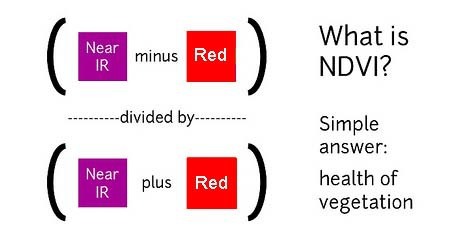](/i/44723) **NDVI = (Near Infrared - Red)/(Near Infrared + Red)** NDVI is a ratio which tries to emphasize photosynthesis while filtering out sun glare. The above equation is run for every pixel, using source data from an infrared photo and a visible light photo, like this pair: [](https://publiclab.org/system/images/photos/000/021/771/original/5390895115_c9d4d38fec_o.jpg) The result can be false-colored to make the high-photosynthesis areas more clear, and used to examine where plants are and how healthy they are. [](https://publiclab.org/system/images/photos/000/021/770/original/PetVISNDVIcomp.png) _Figure above: Normal color photo (right) and normalized difference vegetation index (NDVI) image (left). NDVI image was derived from two color channels in a single photo taken with a camera modified with a special infrared filter. Note that tree trunks, brown grass, and rocks have very low NDVI values because they are not photosynthetic. Healthy plants typically have NDVI values between 0.1 and 0.9. -- @cfastie_ ### Activities Here are a range of activities you can do to produce and interpret your own NDVI imagery, whether downloaded from a satellite imagery provider or [collected yourself using a DIY technique](/wiki/multispectral-imaging) [activities:ndvi] ****   Most DIY converted cameras today (those from Public Lab) use RGN instead of NRG, so the blue channel represents infrared instead of the red channel. That looks like this: [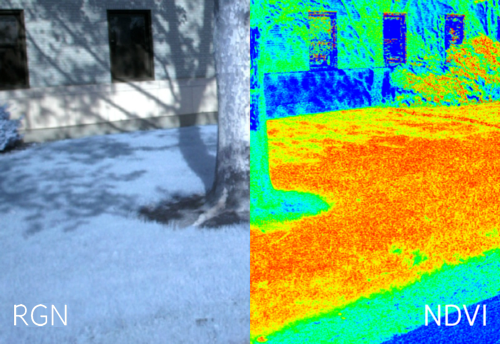](/i/45468?s=o) **** ## NRG imagery Some people are also interested in producing NRG imagery (like the below image), where `Near-Infrared, Red, and Green` are used to compose a picture instead of the usual `Red, Green, and Blue`. [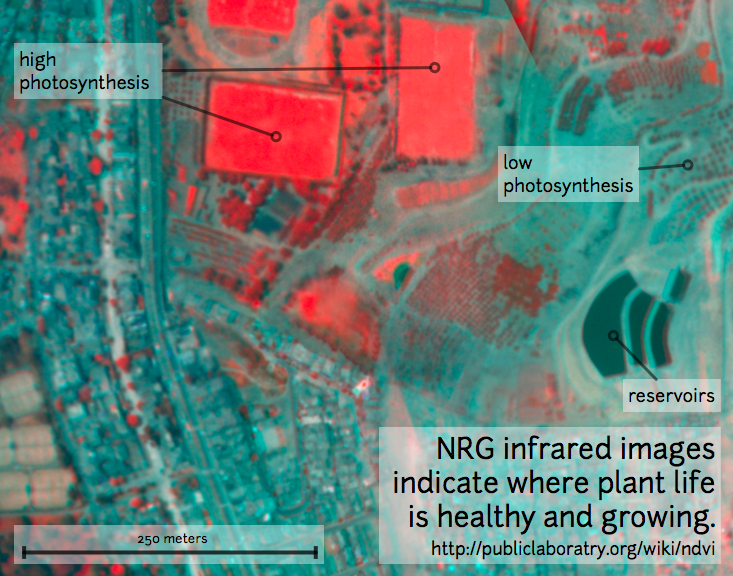](/i/25064) This diagram explains the swapping, which allows us to 'see' infrared as if it were a normal color: [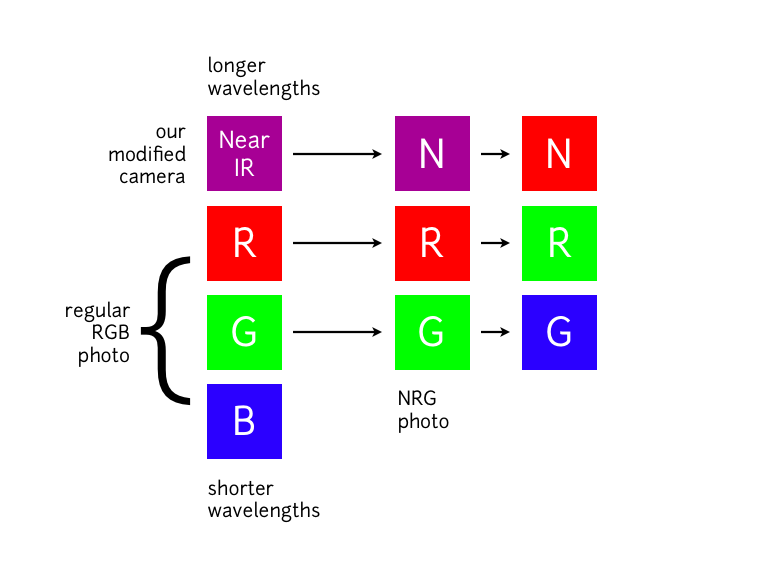](/i/25063) **In NRG images, the deeper and clearer the red color, the denser and healthier the vegetation (more or less).** ### Questions [questions:ndvi] ### Other examples of DIY NDVI imaging From around the internet: Begin watching at 2 minutes to see the resulting imagery: *This topic is part of the [Grassroots Mapping Curriculum](/wiki/mapping-curriculum) series.* **** [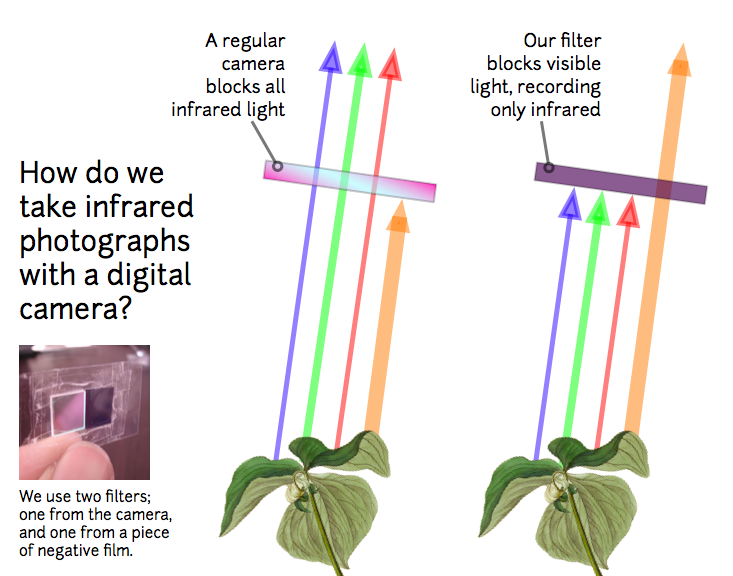](/i/25066) [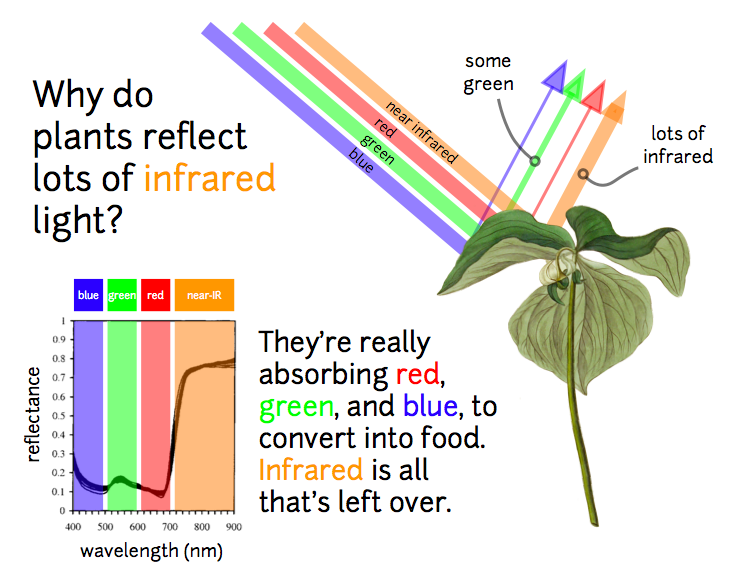](/i/25065) ...
| Author | Comment | Last activity | Moderation | ||
|---|---|---|---|---|---|
| JohnsonC | "@cfastie - That is really interesting to hear and thanks for the link to Ned's note there. I actually have an installed GHI camera that currently a..." | Read more » | almost 9 years ago | |||
| aldehyde | "@JohnsonC - i will thankful if you can share this program with the community. " | Read more » | almost 9 years ago | |||
| cfastie | "Hi JohnsonC, That is a very intriguing chamber you have. Being able to control the spectral quality of the lighting makes some interesting things ..." | Read more » | almost 9 years ago | |||
| JohnsonC | "@aldehyde - It's just a python-made program that basically looks at a pixel of an image based on location (X pixel width, Y pixel height). As far a..." | Read more » | almost 9 years ago | |||
| mnzr | "What model cameras are you using? " | Read more » | almost 9 years ago | |||
| aldehyde | "Hi, tell me please what kind of tool you use for analyze each pixel of a NDVI image? Thanks! " | Read more » | almost 9 years ago | |||
| bortek | "Thanks Clayton. I am on it now. :) " | Read more » | almost 9 years ago | |||
| Claytonb | "@bortek -the blue in the NDVI image is related to the value of the color LUT I applied to the image during processing. I did that to help me to see..." | Read more » | almost 9 years ago | |||
| bortek | "@Claytonb - I am planning to start with a single camera and do some initial testing and learning before I go over to two cameras. Yes the focusing..." | Read more » | almost 9 years ago | |||
| Claytonb | "Here is a similar scene with the Event38 at about the same height. This is with f/4, exp 1/1250, ISO 100 " | Read more » | almost 9 years ago | |||
| Claytonb | "@bortek -I am assuming that the noise is partly due to the filter thickness and light requirement. I believe the Event38 filter is 0.5mm thick and ..." | Read more » | almost 9 years ago | |||
| bortek | "This is really interesting. I have read Ned's article too and it is clearly better contrast when using red filter versus blue. I have just receive..." | Read more » | almost 9 years ago | |||
| cfastie | "That's a good description of what the Rosco blue filter does. Both the blue and the red channels will have a mixture of visible and NIR light. The ..." | Read more » | almost 9 years ago | |||
| Rayishido | "Hi! I was in the filed without internet. I wrote a program that trigger the photo on the second pi when a picture is taken with the first so it is..." | Read more » | almost 9 years ago | |||
| cfastie | "other areas (not foliage) showed values between 0.2 and 0.9 and I don't know why, since there is no photosynthesis occuring there. Getting high ND..." | Read more » | almost 9 years ago | |||
| nachokhan | "Hey, interesting. I am also from Argentina and I am working in the same field. Can you write me? ignacio.rigoni at gmail. Abrazo! " | Read more » | almost 9 years ago | |||
| cfastie | "Do you know how well synchronized the photo pairs are? Do you have to start them both taking photos at the same time, or synchronize their clocks? ..." | Read more » | almost 9 years ago | |||
| Rayishido | "I am using 2 raspberry Pis (one camera on each) and I synchronize the shutters using interrupts. I had some strange behavior (one Pi taking more pi..." | Read more » | almost 9 years ago | |||
| cfastie | "The NDVI image in my last comment was made by stretching only the NIR channel. The default is to stretch both NIR and VIS and that usually works we..." | Read more » | almost 9 years ago | |||
| Rayishido | "Hi Chris, to obtain this picture you stretched the histogram of the visible or visible and IR. As far as I understand to make NDVI picture a visib..." | Read more » | almost 9 years ago | |||
| cfastie | "Both NDVI images look good. Both seem to have some biological meaning and both have reasonable NDVI values in areas that are shady which is very go..." | Read more » | almost 9 years ago | |||
| Rayishido | "Hi Chris! You assumed right! :D The pictures was taken with the pi noir and the blue filter and turned off the automatic white balance to set my o..." | Read more » | almost 9 years ago | |||
| cfastie | "Rayishido, I assume the orangish photo was taken with the PiNoir camera with a blue filter. By calibration I think you mean you used the AWB_gains..." | Read more » | almost 9 years ago | |||
| Rayishido | "Hi! Thank you very much for your answers! I have downloaded Fiji and it's plugin and will test as soon as possible. This weekend I am going to mak..." | Read more » | almost 9 years ago |